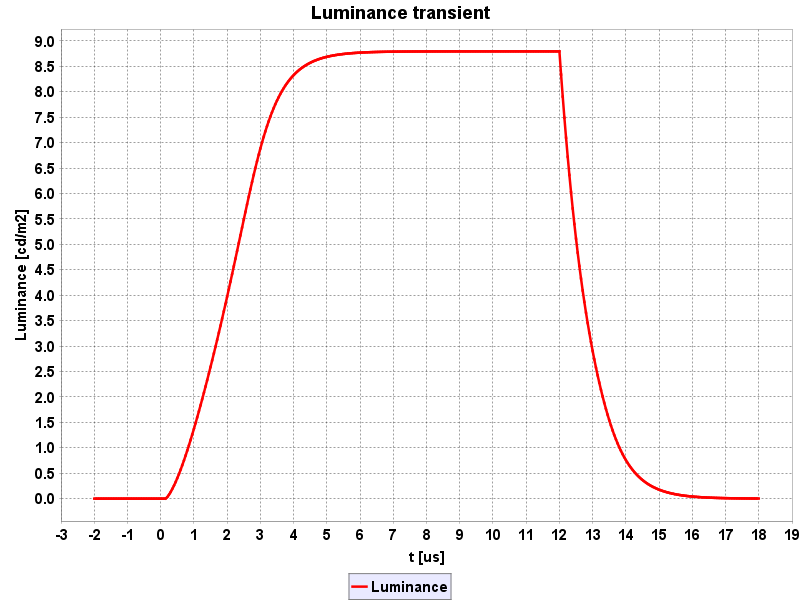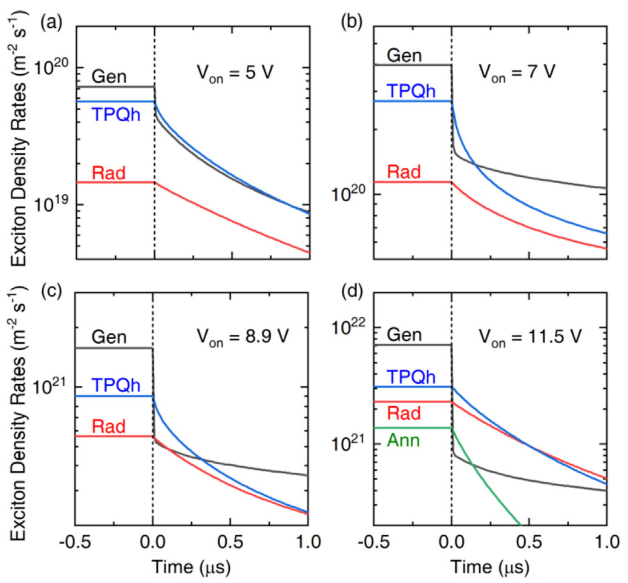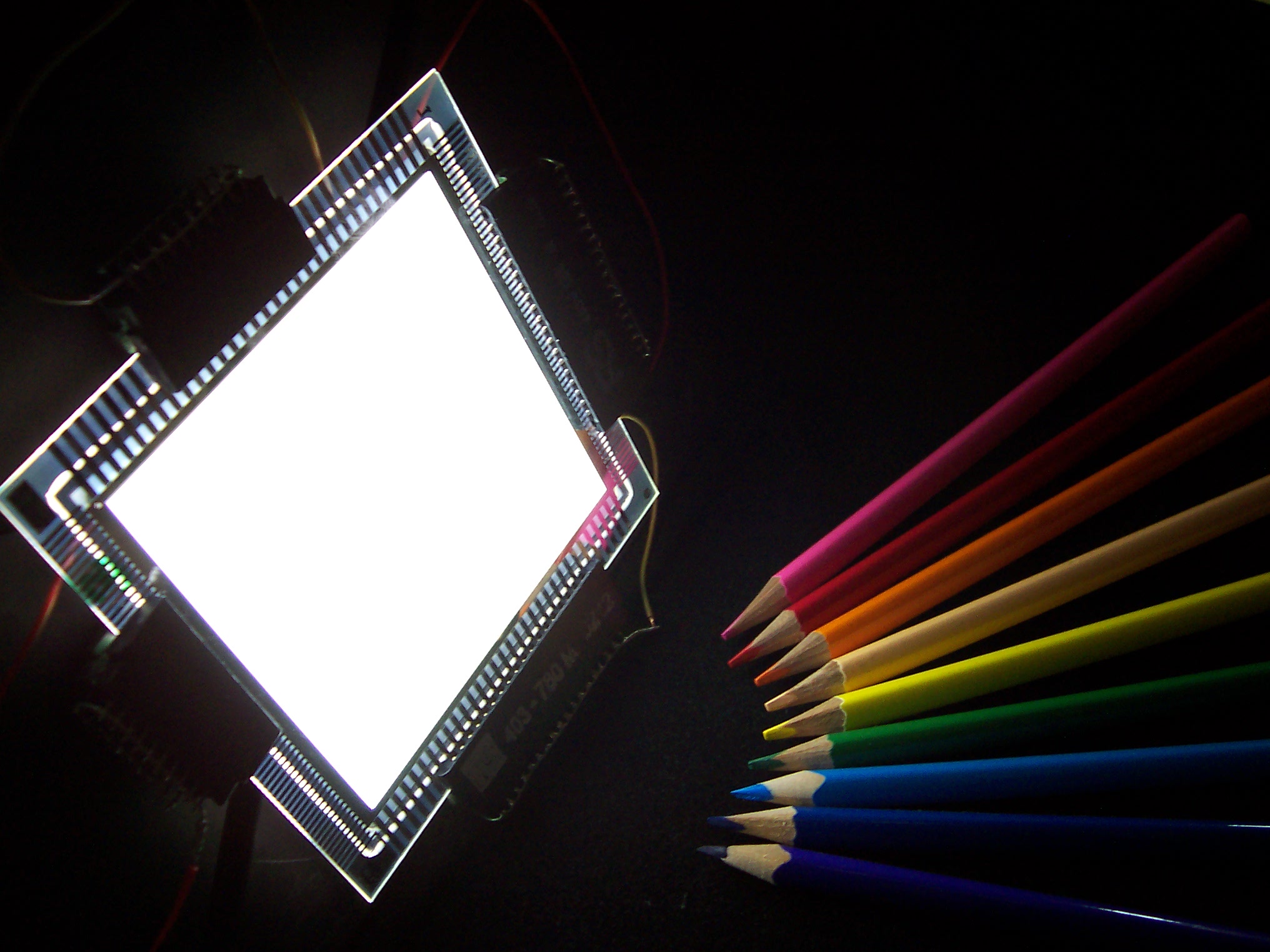DRIFT-Diffusion module
Overview - DC, AC and Transient Analysis - Doping - Excitons - Setfos/Paios Integration
Overview
The electrical characteristics of OLEDs & solar cells are described by the drift-diffusion equations. The drift-diffusion module calculates the current-voltage (IV) characteristics, charge concentration, electric field, and recombination zone of OLEDs & photovoltaic devices. DC, AC, and transient solvers are available.
A range of material properties can be extracted from the electrical simulations.
IV-curves, impedance spectroscopy, and transient responses of OLEDs and solar cells (incl. photo-CELIV).
State-of-the-art mobility models: Poole Frenkel, EGDM/ECDM, constant mobility.
Conductive doping & charge trapping mechanisms.
Injection properties of the contacts.
Exciton recombination, generation, quenching, roll-off, diffusion (fully coupled to optical emission and absorption).
Ionic contribution to simulate perovskite solar cells and light-emitting electrochemical cells (LECs).
DC, AC & Transient Simulation
Setfos calculates the IV curve of OLEDs & solar cells by using suitable physical models and considering mobility, charge traps, doping, recombination, and illumination. You can predict the device characteristics or fit the experimental data.
Setfos impedance solver calculates the equivalent impedance and capacitance. Instead of using an equivalent circuit approximation, Setfos solves directly meaningful physical equations for impedance analysis or Intensity-modulated photocurrent spectroscopy (IMPS).
Transient simulations reveal material dynamics not visible in the IV curves. Simulate experiments like transient electroluminescence (TEL), dark injection transient (DIT), CELIV, Transient Photocurrent (TPC), and more.
Doping & Trapping
Doping is a key method to improve the conductivity of a semiconductor. However, additional elements and impurities in the evaporated or solution-processed material can introduce trap states that influence the charge transport. Deep traps act as recombination centres via the Shockley-Read-Hall mechanism (SRH), whereas a permanent polarity of the charge transport layer can effectively improve charge injection.
Use the Setfos drift-diffusion module to reproduce, quantify and understand the influence of these different effects on the device characteristics. Compare simulation and experimental data directly within the software.
Exciton Physics
Excitons form the link between electrical free charges and the emission/absorption of light. In Setfos, different excitonic processes can be modelled, such as the recombination and dissociation of electron-hole pairs, exciton diffusion, and radiative and non-radiative decay. Setfos even models energy transfer between different exciton states, as in Thermally Activated Delayed Fluorescence (TADF) emitters.
Exciton Processes in OLEDs
Setfos simulates the full formation and decay process of excitons in OLEDs.
Radiative decay and light emission, including Purcell quenching effects.
Non-radiative decay and IQE.
Formation, diffusion and dissociation of excitons.
Efficiency roll-off via triplet-triplet (TTA) and triplet-polaron (TPQ) interaction.
Exciton transfer via TADF.
Exciton Processes in Solar Cells
The absorbed photons create an electron-hole pair inside the solar cell, which dissociates to generate the photo-current.
Setfos is used to:
Calculate the optimal thickness of the absorbing layer.
Calculate recombination losses & fill factor.
Simulate the recombination process with the Langevin or Onsager-Braun models.
The blog paper “TADF OLEDS AND HYPERFLUORESCENT OLED SIMULATION WITH SETFOS” is our tutorial to demonstrate how to simulate TADF-OLEDs with Setfos.
MASTER EQUATION FOR EXCITONS
A new module called Advanced Excitons is available in Setfos.
Our new approach combines the computational efficiency of the 1D drift-diffusion module with the physical accuracy of a discrete 3D Master Equation (ME) model, where excitonic long-range interactions for energy transfer can be taken into account.
Due to the three-dimensional diffusive nature of excitonic energy transfer, it can be physically sounder to model such interactions using a 3D master equation model where the exciton dynamics can be described with molecular resolution. The master equation model implemented in Setfos calculates the singlet and triplet occupation numbers for each molecule (state) over time.
You can find more information on this tutorial on your blog.
Mobile Ionic Charges
Mobile ions play a key role in the electrical behaviour of perovskite solar cells and light-emitting electrochemical cells. Setfos can simulate the effect of mobile anions and cations on the device characteristics.
Fully coupled steady-state and transient modeling.
Understand device operation from electronic and ionic charge profiles.
Simulation of the hysteresis in perovskite photovoltaics. Understand the effect of a given pre-bias or different ramp rates.
Charge Transport across Interfaces
Charge generation and recombination at the interface are key for the operation of tandem OLEDs and tandem solar cells. Setfos is able to describe the interconnection between sub-cells in these devices.
Hopping between different states at the interface.
Advanced injection layer modeling (Charge Generation Layers).
You can consider jumps from the LUMO to the HOMO and the other way around.
Consistent electrical modeling of tandem solar cells, including the recombination junction.
Organic and Hybrid Multijunction. Tandem Perovskite-Silicon Solar Cells.
Comprehensive Device Modeling
Experiments seldom match theoretical expectations that are based on simplified device models. On the other side, with a detailed simulation of different complementary experiments, the empirical behaviour of the sample can be closely modelled. Not just one experiment but a series of measurements need to be considered to build a comprehensive device model.
Setfos-Paios Integration integrates Setfos (Drift-Diffusion, Emission, and Absorption) with Paios. A closer reproduction of the different DC, AC, and transient characterizations performed with Paios means greater confidence in extracted parameters and more consistent material characterization.
Learn more about Paios and Setfos-Paios Integration.


















